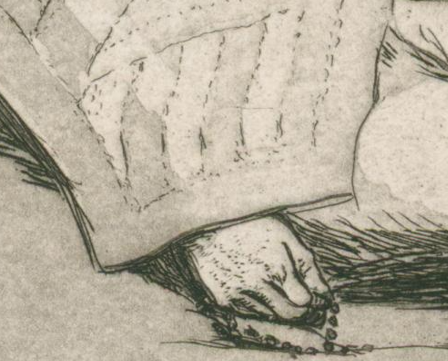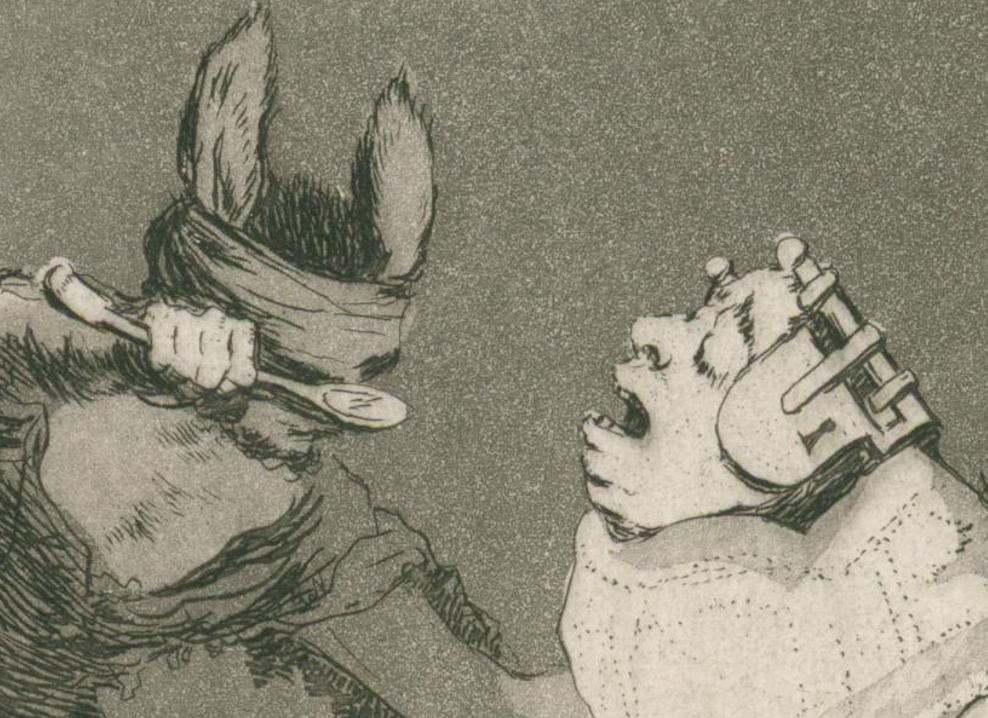



Francisco de Goya, Los Chincillas - (6th edition Plate 50) (1878–1900))
Goya, Spain’s greatest Romantic printmaker, infused Los Caprichos (1799) with biting satire and haunting allegory.
This print is from Goya’s original copper plates. Etching, aquatint, drypoint, and burin. Published by Calcografía Nacional, Madrid, the Spanish national archive and cultural institution, part of the San Fernando Royal Academy of Fine Arts, established in 1789 to conserve the legacy of Spanish graphic art.
In 1803 Goya donated the complete original copper plates to the King of Spain, who then entrusted them to the Calcografía Nacional. This print is from one of their last runs in circa 1900.
Title : Los Chinchillas (The Chinchillas / The Nobility) Goya commented:
"He who hears nothing, knows nothing, and does nothing belongs to the
numerous family of the Chinchillas, which has always been good for
nothing." Contemporary references identify the Chinchilas as nobles: "Those idiots who pride themselves on their nobility, let themselves go to laziness and superstitionn. They close off their understanding with padlocks while they are grossly fed by ignorance." This plate offers a different perspective on the folly of geneological pride illustrated in plate 39. Instead of the earlier plate's self-satisfied and well-dressed ass, this one depicts the nobility as victims of
their own pride living like madmen in their own prisons of ignorance, clearly unfit to play any role in the nation” The complete prints of Francisco de Goya, Miguel Orozco
Dimensions 8 3/4” x 12 1/2”
Excellent Condition - well inked with margin. Excellent coloring.
Collector’s note This example is a Calcografía Nacional posthumous edition (c. 1878–1900), printed on wove ivory paper without watermark. Key features confirm this edition: the printed caption Los Chinchillas beneath the plate and softened aquatint tones from plate wear. While not as scarce as the 1799 first edition, these impressions remain highly collectible. They were pulled from Goya’s own copper plates, offering direct continuity with his hand.
Goya, Spain’s greatest Romantic printmaker, infused Los Caprichos (1799) with biting satire and haunting allegory.
This print is from Goya’s original copper plates. Etching, aquatint, drypoint, and burin. Published by Calcografía Nacional, Madrid, the Spanish national archive and cultural institution, part of the San Fernando Royal Academy of Fine Arts, established in 1789 to conserve the legacy of Spanish graphic art.
In 1803 Goya donated the complete original copper plates to the King of Spain, who then entrusted them to the Calcografía Nacional. This print is from one of their last runs in circa 1900.
Title : Los Chinchillas (The Chinchillas / The Nobility) Goya commented:
"He who hears nothing, knows nothing, and does nothing belongs to the
numerous family of the Chinchillas, which has always been good for
nothing." Contemporary references identify the Chinchilas as nobles: "Those idiots who pride themselves on their nobility, let themselves go to laziness and superstitionn. They close off their understanding with padlocks while they are grossly fed by ignorance." This plate offers a different perspective on the folly of geneological pride illustrated in plate 39. Instead of the earlier plate's self-satisfied and well-dressed ass, this one depicts the nobility as victims of
their own pride living like madmen in their own prisons of ignorance, clearly unfit to play any role in the nation” The complete prints of Francisco de Goya, Miguel Orozco
Dimensions 8 3/4” x 12 1/2”
Excellent Condition - well inked with margin. Excellent coloring.
Collector’s note This example is a Calcografía Nacional posthumous edition (c. 1878–1900), printed on wove ivory paper without watermark. Key features confirm this edition: the printed caption Los Chinchillas beneath the plate and softened aquatint tones from plate wear. While not as scarce as the 1799 first edition, these impressions remain highly collectible. They were pulled from Goya’s own copper plates, offering direct continuity with his hand.
